Last time we wrote about the Albany Bicentennial Tablet commemorating the first church in Albany, and we noted that in addition to the two successive church structures that sat in the middle of State Street at Broadway, there had been a burial ground around (and perhaps within) the church. At the time we said there was “little information on removals,” but it turns out that with some more digging and help from the Friends of Albany History, there is quite a bit of information on removals. We know where the bodies were buried, and then where they were reburied, and then entombed, and then reburied.
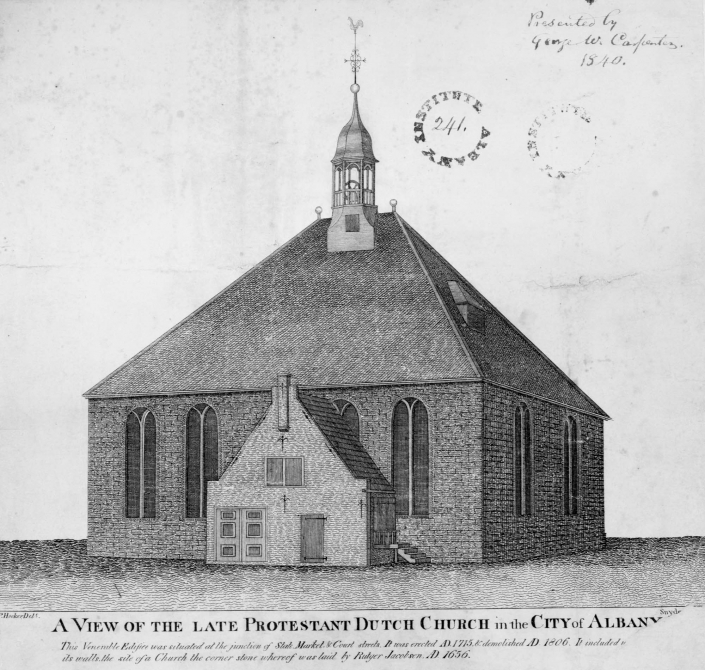
In 1917, Albany historian (and much more) Cuyler Reynolds wrote:
“The burial ground about that Church in the center of State street and Broadway, the busiest crossroads of the city, must have been extremely limited in area. Bodies were certainly buried there, for in 1907, when excavations were made there for conduits and new surface railway tracks, I watched laborers throwing human bones upon carts and saved a few, which now rest in my library near the church picture.
Cuyler Reynolds
“Although the successor to this church edifice on Broadway was the First Reformed Protestant Dutch church on the west side of North Pearl street, corner of Orange street, and it would seemingly be the proper place of deposit for the remains of the “first” Dutch church congregation instead of taking them to another church ground, it was not the case.”
Because the new church at North Pearl and Orange opened in 1799, and it was 1806 before the old one was razed, “there was no special reason to disturb the bodies.” And when that time came, they were moved to an additional Dutch church, the “Second Dutch Church” or “Middle Dutch Church” on the south side of Beaver Street, midway between South Pearl and Green streets. There were by then other burial grounds — one at Eagle and State, “where various churches had their cemeteries side by side,” as well as the Washington parade grounds, now Washington Park. So the Middle Dutch Church burial ground was likely a mix of removals from the original church as well as some new interments.

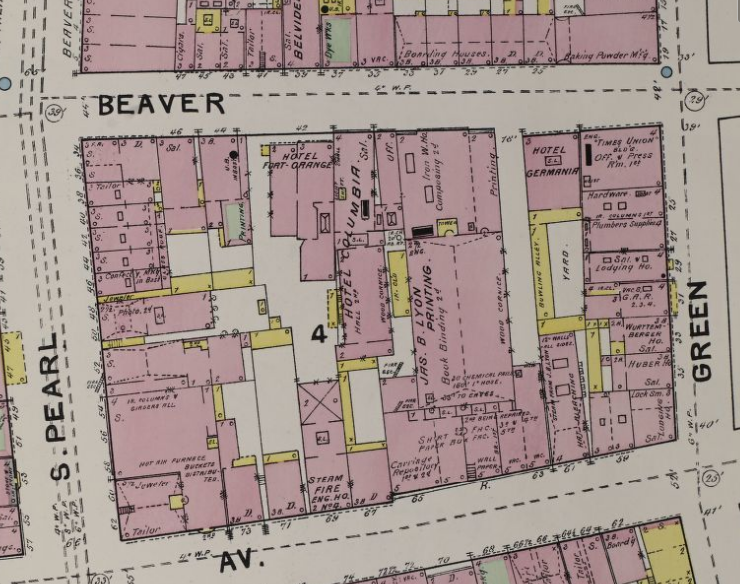
The bones move uptown
Around 1881, a new Dutch Reformed church was built on the northeast corner of Madison Avenue and South Swan Street, and the Beaver Street church remained vacant for some years. When it was to be redeveloped into the public market building and J.B. Lyon printing around 1891, “it became necessary to remove the bodies . . . [and] the Madison Avenue church undertook to care for any of the remains discovered while excavating.”
Reynolds reported “I personally know that a contractor engaged in digging for a foundation for the business block was not overzealous in preserving bits of bones, and his laborers much less so. As a consequence, when a human skull dropped from a cart in the street, I took it with me for preservation, and it may be today in the ‘woodshed’ of the house where I was born, 98 Columbia street, Albany. Had I known that decent disposition was contemplated for the exhumed bits of bones of my own ancestors, I should not have withheld this portion from the rest.”
He further reported that “all the remains dug up and saved from the Beaver street site were placed in a box and deposited beneath the towers of the Madison Avenue Dutch Reformed church, where they were cemented in.”
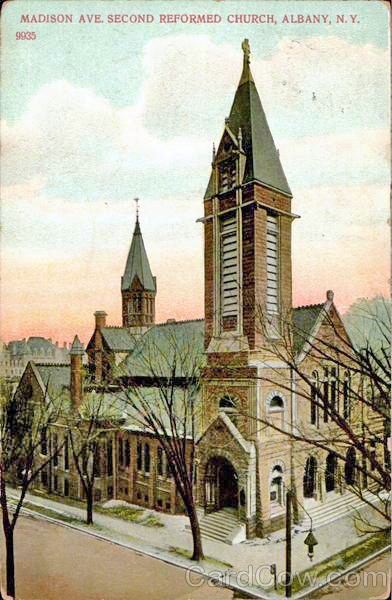
Cemented in? That got our attention. That church stood on that corner, now part of the Empire State Plaza at the south end of the Swan Street Building, until 1937, when it burned dramatically. After it burned, the place of the Dutch church was again taken over by a market — this time, in 1941, a Central Market (later to be known as Price Chopper). Now, of course, it wasn’t the same building – but parts of it were. Because while the church was burned there was apparently nothing wrong with its massive foundation, which sat incongruously beneath the modern Central Market structure until it was demolished (or, perhaps, the foundation may have been buried in place) for construction of the Plaza. And part of us wanted this all to be so . . . that the bones were “cemented in” to the foundation of the church, so that they remained there when it was a Central Market, and thus generations would have shopped above an ossuary without even knowing it. It could still be there!
A Lovely New Crypt
Unfortunately for our story, the bones were better tended than that. Thanks to Paula Lemire, historian of the Albany Rural Cemetery, we found that in fact there was quite a fabulous crypt built in the Madison Avenue Reformed Church to hold those remains. They were originally placed in a simple wooden enclosure, but in 1902 a former member and trustee of the church, Robert Livingston Fryer, made a gift to construct a substantial brick tomb, 10 feet by 5-1/2 feet by 4-1/2 feet high. He also had a floor poured and a varnished wooden ceiling installed, along with gaslighting (the good kind). Headstones found in the Beaver street churchyard, ranging from 1721-1789, were installed on the walls of the crypt area, and the tomb was covered with a slab of brown stone, six feet by three feet by six inches thick, that was originally erected to the memory of Captain Peter Winne, who died in 1757. “The most of the inscriptions on the head-stones are in English, a few in Dutch. They bear odd devices, such as a rising sun with its rays, angel faces, fantastic emblems and some with rather fine scroll work . . . On the top of the tomb is one of four massive brown stone urns, which served as chimney caps of the Beaver street church, which was formerly the edifice of the present congregation. On the north wall hangs a flash-light photograph, showing the wooden structure with top removed, before the improvements were made. Stairs mount to the main floor of the tower vestibule, covered with a trap door. The ventilation is such that the air is as cool and pure as that of an October atmosphere.”
There was also a brass (perhaps bronze) tablet, inscribed with an explanation. It read:
“In Memoriam: In the crypt below are deposited the remains of the dead removed from under stone edifice of the Dutch church which stood at intersection of Jonkers and Brewers (formerly Handelaers) streets, now State street and Broadway, whose names are inscribed on opposite wall. Among them Rev. Petrus Van Driessen, died 1738; Minister of this Church 1712-1738; he laid the cornerstone of State Street Church; and Rev. Cornelius Van Schie, died 1744; Minister of this Church 1733-1744. Also the remains of the dead removed from the yard and tower of the Dutch Church burying ground on Beaver street between South Pearl and Green streets in use until 1789, more than a hundred years. The headstones on walls of Crypt were unearthed in 1882 from the yard of Beaver Street Church. The tomb and this tablet erected 1902 by Robert Livingston Fryer, a former member and trustee of this Church.”
There was also a framed “statement” giving the names of 110 persons buried under the Old Dutch Church on State Street.
Fire!
The church burned spectacularly February 16, 1937.

Oddly, the Times-Union, in reporting on the fire, claimed that the crypt under the main tower contained the “bodies of 900 Colonial dead, principally Indian converts and Negro slaves,” a contention that seems completely unsupported by the listing of names that had been posted at the church.
Following the fire, the congregation borrowed other places of worship for a time, including Temple Beth Emeth and Emmanuel Baptist Church, while they considered rebuilding. But in April 1938, they decided to merge with the First Reformed Church.
The bones weren’t mentioned again, but again thanks to Ms. Lemire, we learned that the contents of the crypt were turned over to Albany Rural Cemetery, and buried in a corner of Section 49 “near the post of the chain between Albany Rural and Beth Emeth;” the stones were placed in another corner of Section 49.

It was reported that the weathercock brought from Holland and which had adorned each of the three successive church buildings, had gone missing in the fire. However, it was found several days later. The weathercock didn’t immediately go off to the First Church on North Pearl, however. In 1939 the Times-Union reported that the bird, which for some reason they said had picked up the moniker “Archie” after the fire, was on display at the New York World’s Fair. Then it went to the First Church – we’ve never seen an adequate explanation for why it hadn’t gone there in the first place.
After the church gave up on rebuilding at that site, Central Markets (much later to become Price Chopper, and later still to become Market 32) chose it for the site of their 12th store, which they built upon the foundation of the old church. The site remained open on the east side for a small parking lot. The store remained there until the area was taken for construction of the Empire State Plaza.
When we first saw a picture of this Central Market, we were very confused by its massive foundation and gothic-arched rear door, now explained by the previous churchiness. We’re personally disappointed that Central Market shoppers weren’t unknowingly checking out just a few feet above the bones of our earliest settlers, but perhaps it’s for the best.
Thanks to Paula Lemire for digging up (so to speak) an extensive article that contains the names of those who were buried under the original Dutch Church and then reinterred in the crypt at Madison and Swan:
CRYPT UNDER THE TOWER VESTIBULE
GIFT OF ROBERT LIVINGSTON FRYER TO THE MADISON AVENUE REFORMED CHURCH
THOSE BURIED PREVIOUS TO 1789
Tomb Holds Remains from Under Dutch Church at State Street and Broadway, and Beaver Street Burial Ground
Through the generosity of Robert Livingston Fryer, of Buffalo, a former member and trustee of the Madison Avenue Reformed church, great improvement has been made this summer in the crypt under the tower entrance of the church. Here, in 1882, were placed in a wooden enclosure the remains of the dead, removed from the tower and yard of the Beaver street church, and thereafter as the Middle Dutch church.
The improvements consist of putting in a cement floor, constructing a brick tomb, 10 ft. by 5 1-2 ft by 4 1-2 ft high, whitening the walls, and making and varnishing a wooden ceiling and lighting overheard with gas. Fastened to the four walls are the head-stones, found in 1882, under three feet of earth, in the Beaver street church yard. These head-stones show dates of burial from 1721 to 1789. A large slab of brown stone, measuring six feet by three feet, by six inches thick, formerly the top of a tomb, is placed on the large tomb. The slab was erected to the memory of Capt. Peter Winne, who died, 1757, in his seventieth year.
The most of the inscriptions on the head-stones are in English, a few in Dutch. They bear odd devices, such as a rising sun with its rays, angel faces, fantastic emblems and some with rather fine scroll work.
Names on Head-stones
The following names appear on the head-stones:
David Van der Heyden and his wife, Gertrude; Catilina Bogert; Elezebet Waldren, wife of Willem; John Waters; Johannes Van Schaick; Maria Dow, wife of Johannes Gansevoort; Eliesabet, wife of Abraham H. Wendell; Harmanus Wendell and wife, Catherine; William Phelen; Lydia Van Veighten, wife of William Bloodgood; Jeremiah Field, Elijse, wife of Frans Wenne; Anthony Van Schaick; William Lush; Gertrude Lush; Neeltije, wife of Thomas Lansing; Gysbert Fonda; and Maria Besset, wife of Abram Bogert.
On the top of the tomb is one of four massive brown stone urns, which served as chimney caps of the Beaver street church, which was formerly the edifice of the present congregation. On the north wall hangs a flash-light photograph, showing the wooden structure with top removed, before the improvements were made. Stairs mount to the main floor of the tower vestibule, covered with a trap door. The ventilation is such that the air is as cool and pure as that of an October atmosphere.
On the east wall is a fine antique brass tablet, made by J. and R. Lamb, of New York city, with the following inscription:
“In Memorium: In the crypt below are deposited the remains of the dead removed from under stone edifice of the Dutch church which stood at intersection of Jonkers and Brewers (formerly Handelaers) streets, now State street and Broadway, whose names are inscribed on opposite wall. Among them Rev. Petrus Van Driessen, died 1738; Minister of this Church 1712-1738; he laid the cornerstone of State Street Church; and Rev. Cornelius Van Schie, died 1744; Minister of this Church 1733-1744. Also the remains of the dead removed from the yard and tower of the Dutch Church burying ground on Beaver street between South Pearl and Green streets in use until 1789, more than a hundred years. The headstones on walls of Crypt were unearthed in 1882 from the yard of Beaver Street Church. The tomb and this tablet erected 1902 by Robert Livingston Fryer, a former member and trustee of this Church.”
On the west wall is a framed engrossed statement giving the names of one hundred and ten persons buried under the old Dutch Church on State street, with a succint history of the different burial grounds of the Dutch Church.
Proposed Tablet
First burying ground of the Dutch Church – 1642-1656, near their Church building; north of Madison avenue and Church street.
Second – 1657-1676, around Dutch Church on State street.
Third – 1676-1789, in Beaver street, abutting on ancient stockade, where in 1811 was built former edifice of this congregation.
Fourth – 1789-1806, on south side of State street, west of High street
Fifth – 1806-1868, on the south side of State street, west of Lexington avenue, now a part of Washington Park.
From a list of burials, 1722-1767, by Barent Bradt, sexton, are taken the names of those persons buried under the Dutch Church, at intersection of State street and Broadway, as follows:
Maria Cuyer, dr. of Abram
Susana Brat, grandmother of Barent Brat
Philip Livingston’s child
Pieter van Dresen’s child
Antie van Eivere
Hendrick Hanse
Philip Verplank’s child
Tierck Visscher
Robert Livingston
Johannes De Peyster’s child
Philip Verplank’s child
Volckerk Van Hoesen
Jan Garretz
Elizabeth Rosie
Samuel Pruyn’s dr.
Evert Wendell’s child
Gerret Roseboom’s dr.
Catharina Lydius
Jan Lansingh
Dirck Ten Broeck’s child
Anna Brat
Christienna Ten Broeck
Isaac Greveraet’s child
Isaac Greveraet’s child
Johannes De Peyster’s child
Johannes Migael
Harmanus Wendell
Isaac Greveraet’s child
Dirck Ten Broeck’s
AnnaMaria Gerritse’s little son
Isaac Bogart’s little son
Johannes A. Cuyler’s child
Dirck Ten Broeck’s little sonJ
ohannes Symonse Vedder’s dr.
Johannes De Peyster’s child
Jan Jans Bleecker
Mallie Leedyus
Rychert Hanse’s wife
Maragrietie Bleecker
Johannes De Peyster’s child
Catharin Cuyler
Domine Van Schie’s child
Ryck Hanse’s child
David A. Schuyler’s little son
Johannes De Peyster’s little child
Marytie Mingael
Ryckert Hansen’s little son
Domine Van Schie’s child
Johannes Schuyler’s wife
Dirck Ten Broeck’s little son
Jan Rose
Domine Petrus Van Driessen
Johannes Bleecker
Gerritie Draeyers
Dominie Van Schie’s child
Jacob Glen’s dr.
Susanna, wife of Johannes Symonse
Jacob Glen’s child
Giertie Lansing
Pieter Van Brugh
Johannes Schuyler
Arieaentie Wendell
Sara Van Brugh Harpert
Jacobse Van Deusen
Debora Hansen
Robert Sanders’ wife
Antony S. Van Schayck’s wife
Robert Sanders’ child
James Stievenson’s child
Domine Cornelis Van Schie
Harmed Vischer
Johannes Roseboom
Johannes De Peyster’s little son
Geradus Groesebeek’s child
Hendk Coster
Cornelis Cuyler’s child
Eysabell Staats
Wife of Johannes Cuyler
Jacob Glen
John Schuyler, Jr.
Gerritie Roseboom
Wife of Johannes Van Rensselaer
Johannes Schuyler
Abraham Cuyler
Wife of Myndert Schuyler
Child of V. P. Douw
Madame Margarita Collans
Lydia Van Vechte
Child of John R. Bleecker
Son of James Stevenson
Wife of Johannes De Peyster
Elbert Gerrits
Nicolaes Bleecker
Dirck Ten Broeck
Child of John R. Bleecker
Elsie Cuyler
Antony Coster
Edward Collins
Elisabeth Corlaer
Luyckas J. Wyngart
Jannetie Gelen
Child of Volckert P. Douw
Myndert Schuyler
Cristina Cuyler
Elisabeth Brat
William Nicolaes
Rutger Bleecker
Madame Van Driessen
Elisabeth Koster
Barent Sanders
The dates of particular burials given in the tablet are omitted here.
The following, composed by Wendell M. L’Amoureux, November, 1849, then a very young man, since a professor in Union college, was published in The Argus, at the time. Prof. L’Amoureux lived in Hudson street, opposite the Middle Dutch church:
The Middle Dutch Churchyard (A Lyric of the Three-Hilled City)
‘Tis the close of an autumn twilight,
The moon is rising slow,
The white urns on the belfry top
Like urns of silver glow;
And the old tower throws in shadow
Over roofs and trees below.
Around are the giant and skeleton elms,
Swaying against the sky,
And the children passing the church-yard.
Hurry fast and stealthily by;
For they see their crooked and ghastly arms
Beckoning fearfully.
Behind them stands in the moonlight,
The column’d porch, and below,
The dust of the holy reposes,
Entombed there long ago;
The sods of a hundred summers
Above their coffins grow.
The solemn tones of the organ,
Pealing at the close of day,
Come creeping beneath the funeral elms,
And across the shadowed way.
In my silent chambers I hear them,
And with them silently pray.
For they come from the holy place within,
And my lonely heart they cheer,
Like that voice from the bless’d in paradise.
The dying sometimes here;
Tho’ the valley of death with its countless graves
Lies between them dark and drear.
The committee of the trustees who superintended the improvements were Gilbert M. Tucker and the undersigned William L. M. Phelps.

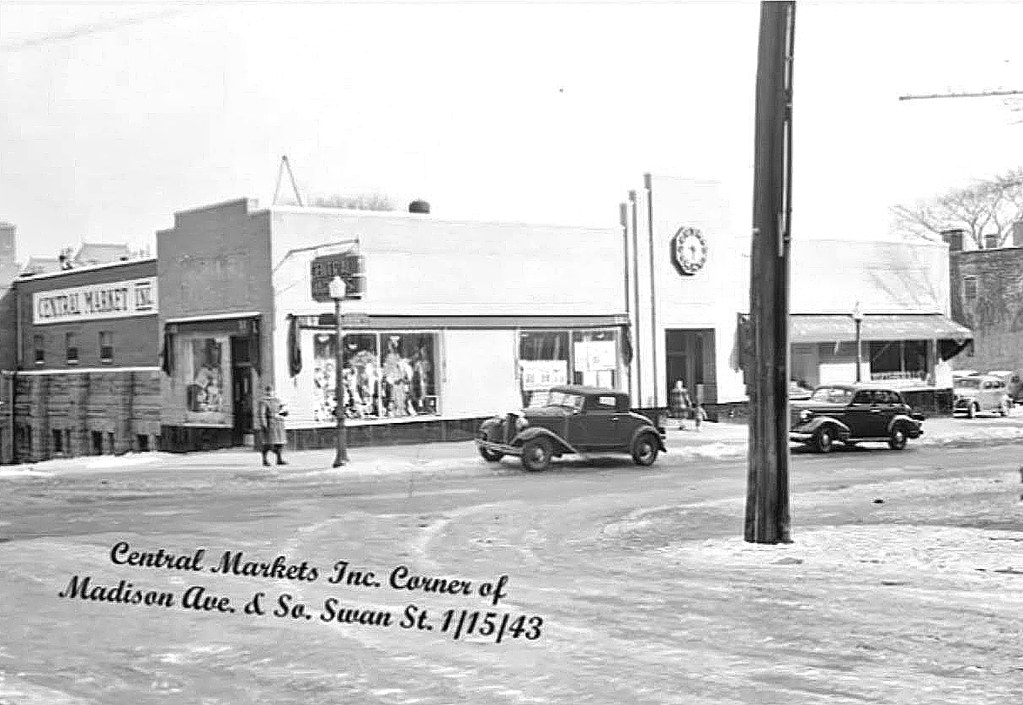
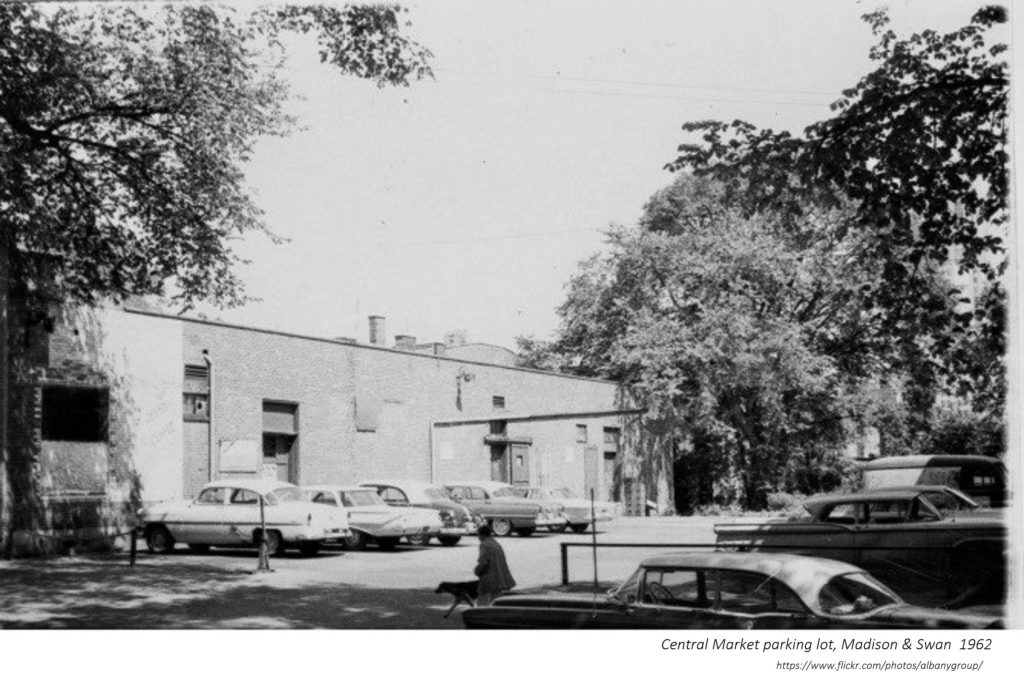
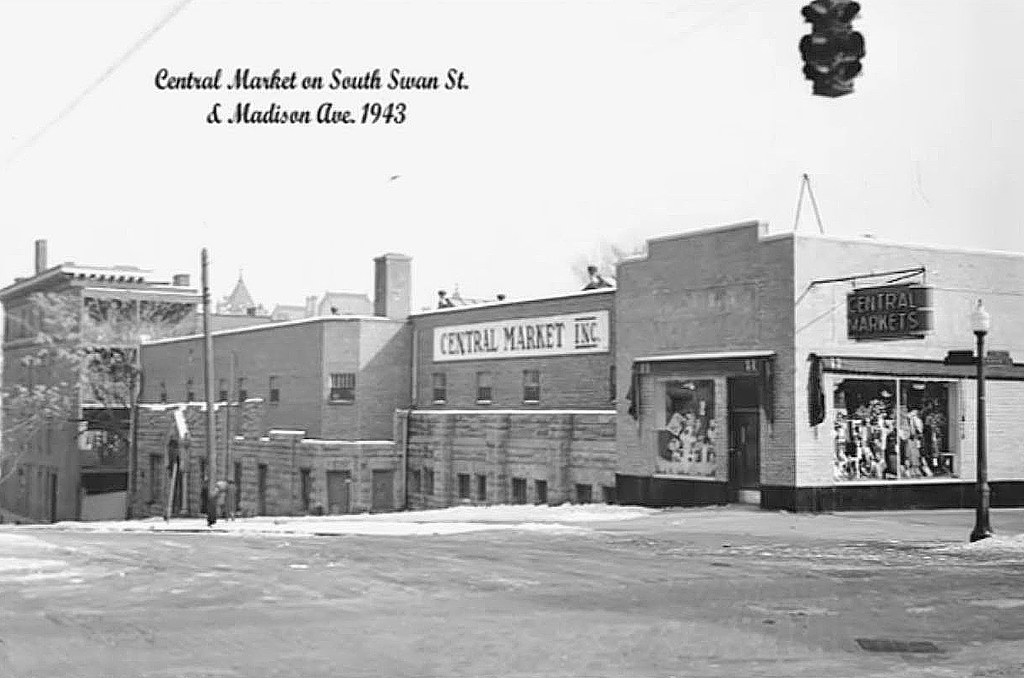
Leave a Reply to Jen Johnson Cancel reply